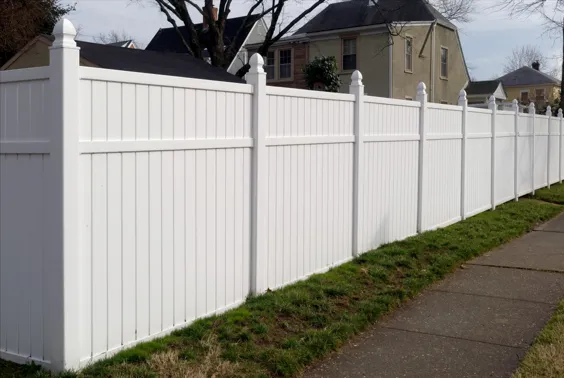Vinyl vs Wood Fences: Pros, Cons, and Cost
Homeowners who want to build new fences between their properties usually experience a dilemma between choosing vinyl vs wood materials. The two fence materials establish separate positions in terms of their monetary expenses together with their expected lifetime durability and preservation requirements. A thorough comparison of vinyl and wood fencing systems will show their distinct features from initial expense to extended value. Your property selection between vinyl and wood fencing becomes easier when you understand their fundamental distinctions in terms of appearance and longevity and financial implications.

Key Points on Vinyl vs Wood Fences
The initial expense for vinyl fencing exceeds wood fencing by 25-35% yet vinyl provides double the lifespan with minimal upkeep throughout 20-30 years.
The combination of natural looks with design freedom is available in wood fences but they require periodic maintenance for staining and sealing during every two to four year period.
The weather-resistant nature of vinyl fencing stands against damage from rotting and insect attacks and wood fences are weak to warping and decay alongside pest infestation.
Wood fence installation costs between $23-42 for each linear foot while vinyl fence installation prices range between $30-55 per linear foot.
The durability and low upkeep needs of vinyl fencing generate superior long-term value even though it starts at a higher cost point than wood fencing.
Initial Installation Costs
The installation expenses for vinyl vs wood fences depend mainly on materials and labor costs.
Wood fencing material costs range between $15 to $30 for each linear foot and vinyl fencing materials cost between $20 and $40 per linear foot. The materials used for vinyl fencing cost 25-35% more than comparable wooden fencing materials across different styles and dimensions.
Labor expenses follow a similar trend. Professional installation expenses for wood fences cost between $8 and $12 per linear foot yet vinyl fences require $10 to $15 per linear foot. The installation process of vinyl panels requires advanced tools together with specialized expertise which drives up their overall cost.
A residential fence project measuring 150 feet requires installation time spanning 2 to 3 days.
A standard 150-foot fence installation costs between $3,450 and $6,300 when constructed with wood materials. The total expenses for a vinyl fence project extend from $4,500 to $8,250.
We should not make our decision based on initial expenses alone when deciding between the options. The long-term preservation along with durability and property value enhancements from vinyl fencing justifies its initial price increase. The long-term benefits of durability and minimal maintenance in vinyl fencing systems lead to reduced costs compared to traditional options.

Durability and Weather Resistance
Natural exposure of fencing materials shows how vinyl fences remain more durable than wood fencing in various weather conditions. Most environmental factors do not affect vinyl fencing as well as they do wood fencing. The durability of vinyl exceeds that of wood because it remains resistant to decay and warping and insects cannot harm it. Vinyl fencing provides cost-effective solutions with diverse color options to match any architectural style.
| Condition | Vinyl | Wood |
|---|---|---|
| Rain/Moisture | No rot, maintains shape | Can rot, warp, swell |
| UV Exposure | Minor fading over 10+ years | Graying, cracking within 2-3 years |
| Insects/Pests | Complete resistance | Vulnerable to termites, ants |
The lifespan of vinyl fencing extends from 20-30 years and more whereas wood fencing needs regular maintenance to reach its typical 10-15 year duration. The maintenance process for wood fences includes periodic sealing alongside staining and repair work to protect against moisture damage and pest invasions. The maintenance needs for vinyl consist only of periodic soap water cleaning to preserve both appearance and structure. Vinyl fencing stands firm in harsh weather while resisting both splintering and breaking regardless of the conditions. Very cold temperatures can cause vinyl to become brittle while wood fencing remains more resilient when properly treated.
Maintenance Requirements
The difference between vinyl vs wood fencing becomes apparent when analyzing their maintenance needs since vinyl requires less work and money for upkeep. The upkeep of vinyl fences requires occasional soap water cleaning yet wood fences need periodic painting or staining or sealing every two to four years to protect against rot and maintain their appearance. The non-porous surface of vinyl fences provides better resistance to stains and discoloration than wood fences do making their maintenance simpler. The maintenance process for wood fences involves checking damaged boards and pest control and observing signs of warping or splitting.
Vinyl Fence Care Basics
The upkeep of your vinyl fence demands basic maintenance routines which will reduce your expenses throughout the years. Regular fence inspections must happen twice yearly to detect loose posts together with damaged parts and mildew symptoms. Immediate response to detected issues will stop damage from worsening.
We have discovered that using a garden hose with mild soap solution serves as the most effective method for regular fence cleaning. A soft-bristled brush should be used to brush away dirt and pollen and other debris after spraying the fence with a garden hose. You can use one part vinegar with three parts water for cleaning tough stains and mildew growth on vinyl fences or purchase specialized cleaners at local hardware stores.
Abrasives cleaners and steel wool along with pressure washers should never be used on vinyl fencing since these products create surface damage through scratching. You should maintain a safe distance between weed whackers and your fence when cutting grass to prevent any damage to the structure. You should never stack snow against your fence during winter because this practice leads to structural damage that will occur gradually throughout time.
Wood Fence Upkeep Tasks
A wood fence requires considerable upkeep when compared to vinyl fencing to keep both its structural elements and visual quality intact. We need to perform annual inspections to detect rotting boards and inspect for loose nails as well as insect damage. Any broken components need immediate substitution to stop the deterioration process.
The fence needs to undergo pressure washing every 2-3 years to eliminate dirt and mold and mildew. Following the cleaning process we need to allow the wood to dry completely before applying fresh weather-resistant stain or paint. This protective layer creates a barrier against moisture damage and UV ray deterioration.
We should perform regular maintenance checks on hardware tightness while handling soil erosion near posts and maintaining the surrounding vegetation. The examination of the fence should occur after weather events with strong winds or heavy rain. We need to use wood preservative on contact points between the fence and the ground to stop rotting and fungal development.
These maintenance expenses increase through time because staining or painting costs between $2-4 per square foot every few years while additional repair costs accumulate along with replacement material expenses.
Aesthetic Options and Appeal
The classic design choices for wood fencing include picket, split rail, shadowbox and post-and-rail while vinyl fencing generally includes panel, privacy and picket styles. The natural wood grain patterns along with staining and painting possibilities make wood a versatile material yet vinyl fences are restricted to factory-made color options such as white, tan and gray. Wood allows customization through decorative post caps and lattice work and special cut patterns yet vinyl design elements consist of pre-molded components which manufacturers provide. The ornamental wood fences described at texasfence.com/wood-fence-styles-guide/ serve dual functions by creating outdoor setting improvements through flexible designs while allowing personal style customization.
Design Styles Available
The aesthetic design choices for vinyl vs wood fencing serve different purposes in improving your property’s visual appeal. Wood fencing provides homeowners with several design choices that include traditional picket designs and split rail and board-on-board and shadowbox and solid privacy configurations. These traditional design choices complement different architectural styles especially colonial craftsman and rustic houses.
The available vinyl fencing styles duplicate well-known wood fence patterns which manufacturers produce as pre-designed products. The selection includes basic privacy panels and lattice-topped sections along with post-and-rail designs and picket-style options. The design options for vinyl are restricted compared to wood fencing but manufacturers now provide woodgrain effects along with various color options that extend past traditional white.
The flexibility in design choices stands higher with wood fencing. We can customize the dimensions of wooden boards and their arrangement as well as modify their cuts while also installing decorative elements on posts and adding special trim elements. The designs of vinyl come from the factory but owners can enhance them through the use of different post caps and decorative accent pieces. The ability to meet specific HOA design specifications and architectural elements makes wood more adaptable but vinyl provides standardized solutions with longer-lasting visual appeal.
Color and Finish Options
The aesthetic value of wood fencing derives primarily from three available finish options: natural, stained, or painted. Natural wood creates a rustic appearance that most home owners appreciate while stains allow the wood grain to shine through and serve as a protective layer. Painting provides endless color options for users though it needs constant upkeep to stop paint from peeling and chipping.
The limited color palette for vinyl fencing consists of factory-made color choices. You can usually find these options in the market:
- Traditional white – The most popular choice, offering a clean, classic look that complements most architectural styles
- Tan and beige variations – Neutral options that blend well with landscape features
- Gray tones – Modern alternatives that hide dirt and complement contemporary homes
The restricted color selection of vinyl materials serves to achieve long-lasting looks that need no additional finishing work. The color material extends throughout its entire structure rather than existing only on the surface. Wood provides better design flexibility yet needs periodic maintenance for its appearance to stay intact. Vinyl fences trade color diversity for long-lasting color consistency while wood fencing provides design flexibility through regular maintenance requirements.
Environmental Impact
The selection between vinyl fencing and wood fencing creates different environmental tradeoffs that homeowners should take into account. We need to study the complete environmental impact of both materials starting from production until disposal to make sustainable decisions.
| Environmental Factor | Wood Fencing | Vinyl Fencing |
|---|---|---|
| Production Impact | Lower energy use, renewable resource | High energy use, petroleum-based |
| Biodegradability | Naturally decomposes | Non-biodegradable |
| Chemical Treatment | Requires preservatives | No treatment needed |
| Lifespan | 15-20 years | 30+ years |
| Recyclability | Fully recyclable | Limited recycling options |
Wood fences derive from renewable wood sources and obtain their materials from sustainable forest certifications which makes them an eco-friendly choice. Yet the use of pressure-treated lumber requires attention to the chemical substances that escape into the soil. Although vinyl does not decompose and requires high energy production for manufacturing it stays durable long enough to minimize replacement needs. Vinyl production generates dangerous substances but its extended lifespan means owners need fewer replacement products and maintenance supplies throughout its lifetime. The numerous design options available for vinyl fences allow them to match any residential design scheme as they are described on Texas Fence.
Property Value Considerations
In addition to environmental concerns homeowners need to think about how different fence materials affect their property’s market value. Both vinyl and wood fences increase home worth but they achieve this value increase through different mechanisms. Wood fences appeal to buyers who want traditional charm and natural aesthetic appeal but vinyl fences appeal to those who want modern looks with low maintenance needs. Wood fences deliver a 50-75% return on investment as added home value especially when cedar or redwood premium materials are used. Vinyl fences maintain their original cost value between 65-85% because of their resistance to damage and low upkeep requirements. According to real estate specialists fences that are well-maintained whether they are wood or vinyl will boost marketability of properties by 2-5%. Wood fences which receive proper maintenance become more appealing to homebuyers which increases their market value. Our research shows that local preferences shape the extent to which different materials increase property value. Wood fences better match traditional architectural styles and buyer preferences in traditional neighborhoods. The return on investment for vinyl fencing tends to be higher in modern developments because it fits with modern home aesthetics and lifestyle expectations.
Choosing the Right Material
The selection between vinyl vs wood fencing hinges primarily on your personal requirements together with climate elements and financial restrictions. It is advisable to check how elements like wind intensity, sunlight strength and moisture levels affect your property. The moisture resistance of vinyl makes it superior to wood in regions with wet conditions because vinyl remains resistant to warping and rotting.
Regions with extreme temperature variations require us to think about vinyl becoming brittle in cold temperatures while it expands during hot temperatures. The right treatment methods enable wood to maintain its structural integrity across different temperature ranges. The final decision will depend on the required aesthetic style and the HOA regulations of our neighborhood which have specific rules about building materials.
The multiple diverse style options available for vinyl fencing make it an excellent selection for property owners who need both functionality and visual appeal.
We need to consider our ability to perform maintenance tasks. Wood offers the opportunity to change its appearance through staining or painting if we are ready to perform regular maintenance tasks. The combination of vinyl’s colorfast properties and low maintenance requirements makes it an excellent choice for property owners who want a low-maintenance solution. The fence selection process goes beyond fence functionality because it determines the lasting quality of our property’s appearance and functionality.
Frequently Asked Questions About Vinyl vs Wood Fences
The installation of Vinyl vs Wood Fences requires special procedures when the installation site has uneven terrain.
Both types of fencing can be installed on slopes by our team. Vinyl fences need extra costs for custom cuts because they are less flexible than wood and need stepped or contoured installation for following the terrain.
What is the time needed to complete the installation of Vinyl vs Wood Fences?
Our crew requires 2-3 days to complete wood fencing projects that reach 100 feet but vinyl installation takes 1-2 days because it comes pre-fabricated. The installation period depends on weather conditions together with terrain difficulties and the number of workers.
Does the Wind Cause Vinyl Fences to Make Any Audible Sounds?
The durability of vinyl fences in strong wind conditions will be confirmed by us. We suggest checking post depth and proper installation methods and selecting high-quality panels with reinforced construction to reduce the noise.
What type of building permits are needed for installing both vinyl and wood fences?
Most cities require permits for both vinyl vs wood fences since they exceed the 6-foot height limit. We need to verify the specific requirements with our local building department.
Can we reuse existing wood fence posts for building a new vinyl fence?
Using weathered wood posts for vinyl fencing installation is not advisable because they fail to provide adequate structural support. The installation of new vinyl-specific posts guarantees both stability and performance for the long run.
Takeaway
The evaluation of vinyl vs wood fencing factors involved a comparison of immediate and long-term costs. The high initial cost of vinyl fencing may discourage some buyers but the reduced maintenance needs and longer lifespan make up for the expenses. The traditional charm of wood fencing requires continuous maintenance costs and has a shorter lifespan. We suggest evaluating local weather patterns and ownership duration to achieve the best possible return on investment.








